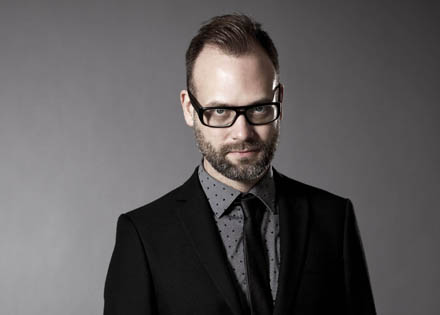
Scoring a film that contains upwards of 100 songs—either in part or complete—in addition to a background score, calls for the kind of composer who can turn with ease from classical to jazz to rock to hip-hop and so on. For Sing director Garth Jennings, the task fell to a longtime collaborator with astonishing versatility in film and TV (The Hitchhiker’s Guide to the Galaxy, The League of Gentlemen); ballet (Alice’s Adventures in Wonderland); pop arrangements (Paul McCartney, Tom Jones) and even played in a band (The Divine Comedy).
We asked composer Joby Talbot to tell us about creating the score for Sing, starting with his creative adjustments to working in animation.

JOBY: It wasn’t the scoring that was different. We treated the score as if was for a live action film. The difference was in the overall process. For Sing, they liked to see the music evolving, just as they liked to see the animation as it became more rendered, lit and more sophisticated. It required sort of a “rolling in” of the music, which is not what I normally would have done. It took some getting used to, but I understood and adapted to it.
Another difference was the level of exactitude. The film, the characters and the situations seem totally believable and relatable, even everything’s been created. But they make it feel so real that if I, as composer, were to deviate off the message—even in the simplest way—it breaks the spell. So I had to be really careful about what worked. You can throw it off if you go too far in either direction.
GREG: Sing was often referred to as an animated “American Idol,” yet the film goes far beyond the competition and is really about the lives of several talented characters. You get very invested in them and want to see them succeed.

Joby Talbot, Portrait, 2011, Credit: Johan Persson
JOBY: I think it’s a love letter to music. It takes the idea of a song competition but then it makes such a lovely thing out of it. It’s all about how people from all different backgrounds can be brought together by music, having this shared musical experience. It’s a beautiful film.
GREG: The music in the film is a lot more eclectic than one might expect, too. It’s not focused solely on contemporary pop. There’s even a Beatles song, “Golden Slumbers,” that figures emotionally at the beginning, middle and end.
JOBY: I worked on the arrangement for “Golden Slumbers” with Mark Graham. We hear it at the beginning in a big, Broadway rendition, in the middle at a sad moment, then triumphantly at the end. For the way it’s sung in the middle, we recorded it like a magical Julie Andrews fairy godmother sort of thing.
I’m pleased that the songs were more than top-ten pop down the line. It’s great for kids, who might not know all of this music. When Garth Jennings and I were growing up in England, there was an amazing eclecticism about the music on the charts back then, but it has kind of become sort of formulaic. Garth is a voracious consumer of music. He’s got impeccable taste and likes music from everywhere.
GREG: With the success of Sing–and another little musical film called La La Land—do you think that you and Garth might create original songs for a new movie musical anytime soon?
JOBY: We’ve always had it on our list of things to do. Garth and I have had an idea for a film like that for some time. And it could be an animated film. We’ve got a lot of great ideas—and a whole hard drive full of songs waiting!
- REVIEW: “Pencils Vs. Pixels” - November 6, 2023
- “Jellystone!” Creator C.H. Greenblatt: “This Show is a Love Letter” - July 21, 2021
- REVIEW: “The Puppetoon Movie 2” Blu-ray/DVD Set - February 3, 2021


 January 23rd, 2017
January 23rd, 2017  Greg Ehrbar
Greg Ehrbar  Posted in
Posted in  Tags:
Tags: 






